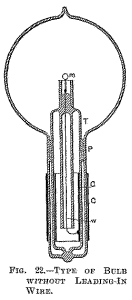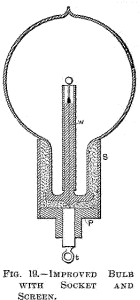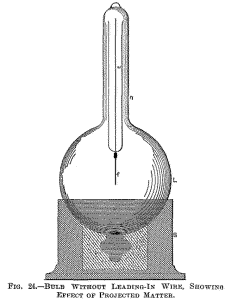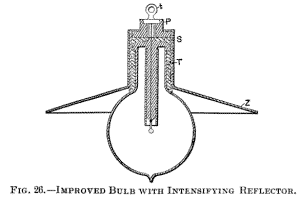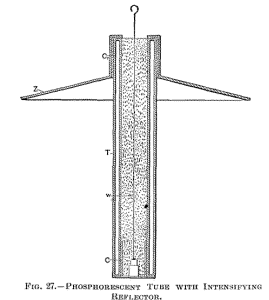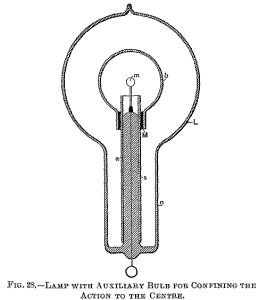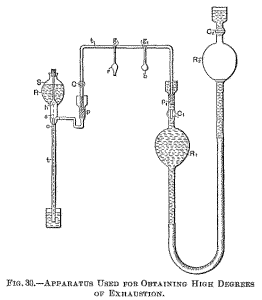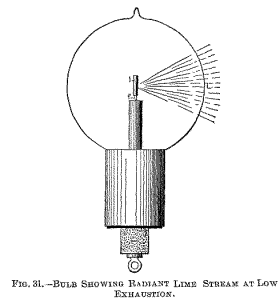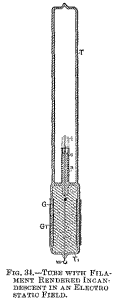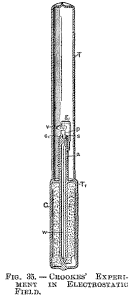|
At first, when the bombardment begins, most of the work is performed on the surface of the button, but when a highly conducting photosphere is formed the button is comparatively relieved. The higher the incandescence of the photosphere the more it approaches in conductivity to that of the electrode, and the more, therefore, the solid and the gas form one conducting body.
The consequence is that the further is forced the incandescence the more work, comparatively, is performed on the gas, and the less on the electrode. The formation of a powerful photosphere is consequently the very means for protecting the electrode. This protection, of course, is a relative one, and it should not be thought that by pushing the incandescence higher the electrode is actually less deteriorated.
Still, theoretically, with extreme frequencies, this result must be reached, but probably at a temperature too high for most of the refractory bodies known. Given, then, an electrode which can withstand to a very high limit the effect of the bombardment and outward strain, it would be safe no matter how much it is forced beyond that limit. In an incandescent lamp quite different considerations apply.
There the gas is not at all concerned:
the whole of the work is performed on the filament; and the life of
the lamp diminishes so rapidly with the increase of the degree of
incandescence that economical reasons compel us to work it at a low
incandescence. But if an incandescent lamp is operated with currents
of very high frequency, the action of the gas cannot be neglected,
and the rules for the most economical working must be considerably
modified.
This loss in the bulb is principally dependent on the potential of the impulses and on the electric density on the surface of the electrode. In employing very high frequencies the loss of energy by the bombardment is greatly reduced, for, first, the potential needed to perform a given amount of work is much smaller; and, secondly, by producing a highly conducting photosphere around the electrode, the same result is obtained as though the electrode were much larger, which is equivalent to a smaller electric density.
But be it by the diminution of the maximum potential or of the density, the gain is effected in the same manner, namely, by avoiding violent shocks, which strain the glass much beyond its limit of elasticity. If the frequency could be brought high enough, the loss due to the imperfect elasticity of the glass would be entirely negligible.
The loss due to bombardment of the globe
may, however, be reduced by using two electrodes instead of one. In
such case each of the electrodes may be connected to one of the
terminals; or else, if it is preferable to use only one wire, one
In experimental bulbs the leading-in wire is most generally used on account of convenience, as in employing condenser coatings in the manner indicated in Fig. 22, for example, there is some difficulty in fitting the parts, but these difficulties would not exist if a great many bulbs were manufactured; otherwise the energy can be conveyed through the glass as well as through a wire, and with these high frequencies the losses are very small.
Such illuminating devices will
necessarily involve the use of very high potentials, and this, in
the eyes of practical men, might be an objectionable feature. Yet,
in reality, high potentials are not objectionable—certainly not in
the least as far as the safety of the devices is concerned.
But the practical conditions require not only the judicious determination of the dimensions of the apparatus; they likewise necessitate the employment of energy of the proper kind. It is easy, for instance, to construct a transformer capable of giving, when operated from an ordinary alternate current machine of low tension, say 50,000 volts, which might be required to light a highly exhausted phosphorescent tube, so that, in spite of the high potential, it is perfectly safe, the shock from it producing no inconvenience.
Still, such a transformer would be expensive, and in itself inefficient; and, besides, what energy was obtained from it would not be economically used for the production of light. The economy demands the employment of energy in the form of extremely rapid vibrations. The problem of producing light has been likened to that of maintaining a certain high-pitch note by means of a bell. It should be said a barely audible note; and even these words would not express it, so wonderful is the sensitiveness of the eye.
We may deliver powerful blows at long intervals, waste a good deal of energy, and still not get what we want; or we may keep up the note by delivering frequent gentle taps, and get nearer to the object sought by the expenditure of much less energy. In the production of light, as far as the illuminating device is concerned, there can be only one rule—that is, to use as high frequencies as can be obtained; but the means for the production and conveyance of impulses of such character impose, at present at least, great limitations.
Once it is decided to use very high
frequencies, the return wire becomes unnecessary, and all the
appliances are simplified. By the use of obvious means the same
result is obtained as though the return wire were used. It is
sufficient for this purpose
The contact with the bulb was, of
course, quite unnecessary. It is easy, by using a rather large bulb
with an exceedingly small electrode, to adjust the conditions so
that the latter is brought to bright incandescence by the mere
approach of the experimenter within a few feet of the bulb, and that
the incandescence subsides upon his receding.
In Fig. 24, for example, an
experimental bulb L is shown, which is provided with a neck n on the
top for the application of an external tinfoil coating, which may be
connected to a body of larger surface. Such a lamp as illustrated in Fig. 25 may also be lighted by connecting the tinfoil coating on the neck n to the terminal, and the leading-in wire w to an insulated plate. If the bulb stands in a socket upright, as shown in the cut, a shade of conducting material may be slipped in the neck n, and the action thus magnified.
A more perfected arrangement used in some of these bulbs is illustrated in Fig. 26. In this case the construction of the bulb is as shown and described before, when reference was made to Fig. 19. A zinc sheet Z, with a tubular extension T, is slipped over the metallic socket S. The bulb hangs downward from the terminal t, the zinc sheet Z, performing the double office of intensifier and reflector. The reflector is separated from the terminal t by an extension of the insulating plug P.
A similar disposition with a
phosphorescent tube is illustrated in Fig. 27. The tube T is
prepared from two short tubes of a different diameter, which are
sealed on the ends. On the lower end is placed an outside conducting
coating C, which connects to the wire w. The wire has a hook on the
upper end for suspension, and passes through the centre of the
inside tube, which is filled with some good and tightly packed
insulator. On the outside of the upper end of the tube T is another
conducting coating C1 upon which is slipped a metallic reflector Z,
which should be separated by a thick insulation from the end of wire
w.
If an iron rod be held within the small helix it is quickly brought to a high temperature, indicating the passage of a strong current through the helix. How does the insulated sphere act in this case? It can be a condenser, storing and returning the energy supplied to it, or it can be a mere sink of energy, and the conditions of the experiment determine whether it is more one or the other. The sphere being charged to a high potential, it acts inductively upon the surrounding air, or whatever gaseous medium there might be.
The molecules, or atoms, which are near the sphere are of course more attracted, and move through a greater distance than the farther ones. When the nearest molecules strike the sphere they are repelled, and collisions occur at all distances within the inductive action of the sphere. It is now clear that, if the potential be steady, but little loss of energy can be caused in this way, for the molecules which are nearest to the sphere, having had an additional charge imparted to them by contact, are not attracted until they have parted, if not with all, at least with most of the additional charge, which can be accomplished only after a great many collisions.
From the fact that with a steady potential there is but little loss in dry air, one must come to such a conclusion. When the potential of the sphere, instead of being steady, is alternating, the conditions are entirely different. In this case a rhythmical bombardment occurs, no matter whether the molecules after coming in contact with the sphere lose the imparted charge or not; what is more, if the charge is not lost, the impacts are only the more violent.
Still if the frequency of the impulses be very small, the loss caused by the impacts and collisions would not be serious unless the potential were excessive. But when extremely high frequencies and more or less high potentials are used, the loss may be very great. The total energy lost per unit of time is proportionate to the product of the number of impacts per second, or the frequency and the energy lost in each impact.
But the energy of an impact must be proportionate to the square of the electric density of the sphere, since the charge imparted to the molecule is proportionate to that density. I conclude from this that the total energy lost must be proportionate to the product of the frequency and the square of the electric density; but this law needs experimental confirmation. Assuming the preceding considerations to be true, then, by rapidly alternating the potential of a body immersed in an insulating gaseous medium, any amount of energy may be dissipated into space.
Most of that energy then, I believe, is
not dissipated in the form of long ether waves, propagated to
considerable distance, as is thought most generally, but is
consumed—in the case of an insulated sphere, for example—in impact
and collisional losses—that is, heat vibrations—on the surface and
in the vicinity of the sphere. To reduce the dissipation it is
necessary to work with a small electric density—the smaller the
higher the frequency.
This would seem to make it very difficult to tell from the measured or computed capacity of an air condenser its actual capacity or vibration period, especially if the condenser is of very small surface and is charged to a very high potential. As many important results are dependent upon the correctness of the estimation of the vibration period, this subject demands the most careful scrutiny of other investigators.
To reduce the probable error as much as possible in experiments of the kind alluded to, it is advisable to use spheres or plates of large surface, so as to make the density exceedingly small. Otherwise, when it is practicable, an oil condenser should be used in preference. In oil or other liquid dielectrics there are seemingly no such losses as in gaseous media. It being impossible to exclude entirely the gas in condensers with solid dielectrics, such condensers should be immersed in oil, for economical reasons if nothing else; they can then be strained to the utmost and will remain cool.
In Leyden jars the loss due to air is
comparatively small, as the tinfoil coatings are large, close
together, and the charged surfaces not directly exposed; but when
the potentials are very high, the loss may be more or less
considerable at, or near, the upper edge of the foil, where the air
is principally acted upon. If the jar be immersed in boiled-out oil,
it will be capable of performing four times the amount of work which
it can for any length of time when used in the ordinary way, and the
loss will be inappreciable.
In such case, as before stated, probably only little of the energy of the vibrations set up would be lost into space in the form of long ether radiations, but most of the energy, I think, would spend itself in molecular impacts and collisions, and pass off into space in the form of short heat, and possibly light, waves. As both the frequency of the vibrations of the charge and the potential are in all probability excessive, the energy converted into heat may be considerable.
Since the density must be unevenly
distributed, either in consequence of the irregularity of the
earth's surface, or on account of the condition of the atmosphere in
various places, the effect produced would accordingly vary from
place to place. Considerable variations in the temperature and
pressure of the atmosphere may in this manner be caused at any point
of the surface of the earth. The variations may be gradual or very
sudden, according to the nature of the general disturbance, and may
produce rain and storms, or locally modify the weather in any way. The globe L has in this case a large neck n, allowing the small bulb b to slip through. Otherwise the construction is the same as shown in Fig. 18, for example. The small bulb is conveniently supported upon the stem s, carrying the refractory button m. It is separated from the aluminium tube a by several layers of mica M, in order to prevent the cracking of the neck by the rapid heating of the aluminium tube upon a sudden turning on of the current.
The inside bulb should be as small as
possible when it is desired to obtain light only by incandescence of
the electrode. If it is desired to produce phosphorescence, the bulb
should be larger, else it would be apt to get too hot, and the
phosphorescence would cease. In this arrangement usually only the
small bulb shows phosphorescence, as there is practically no
bombardment against the outer globe. In some of these bulbs
constructed as illustrated in Fig. 28 the small tube was
coated with phosphorescent paint, and beautiful effects were
obtained. Instead of making the inside bulb large, in order to avoid
undue heating, it answers the purpose to make the electrode m
larger. In this case the bombardment is weakened by reason of the
smaller electric density.
The principal advantage of this construction was that it allowed of reaching extremely high vacua, and, at the same time use a large bulb. It was found, in the course of experiences with bulbs such as illustrated in Fig. 29, that it was well to make the stem s near the seal at e very thick, and the leading-in wire w thin, as it occurred sometimes that the stem at e was heated and the bulb was cracked. Often the outer globe L was exhausted only just enough to allow the discharge to pass through, and the space between the bulbs appeared crimson, producing a curious effect. In some cases, when the exhaustion in globe L was very low, and the air good conducting, it was found necessary, in order to bring the button m to high incandescence, to place, preferably on the upper part of the neck of the globe, a tinfoil coating which was connected to an insulated body, to the ground, or to the other terminal of the coil, as the highly conducting air weakened the effect somewhat, probably by being acted upon inductively from the wire w, where it entered the bulb at e.
Another difficulty—which, however, is
always present when the refractory button is mounted in a very small
bulb—existed in the construction illustrated in Fig. 29,
namely, the vacuum in the bulb b would be impaired in a
comparatively short time.
As the brush, or flame, would gain rigidity in virtue of the inertia of the particles, the exchange of the latter would be prevented. This would necessarily occur, for, the number of the impulses being augmented, the potential energy of each would diminish, so that finally only atomic vibrations could be set up, and the motion of translation through measurable space would cease. Thus an ordinary gas burner connected to a source of rapidly alternating potential might have its efficiency augmented to a certain limit, and this for two reasons—because of the additional vibration imparted, and because of a slowing down of the process of carrying off.
But the renewal being rendered
difficult, and renewal being necessary to maintain the burner, a
continued increase of the frequency of the impulses, assuming they
could be transmitted to and impressed upon the flame, would result
in the "extinction" of the latter, meaning by this term only the
cessation of the chemical process.
But what is the ratio of the frequency
of the collisions and that of the vibrations set up? Certainly it
must be incomparably smaller than that of the knocks of the bell and
the sound vibrations, or that of the discharges and the oscillations
of the condenser. We may cause the molecules of the gas to collide
by the use of alternate electric impulses of high frequency, and so
we may imitate the process in a flame; and from experiments with
frequencies which we are now able to obtain, I think that the result
is producible with impulses which are transmissible through a
conductor.
Accordingly I prepared a tube about 1 inch in diameter and 1 meter long, with outside coating at each end. The tube was exhausted to a point at which by a little working the thread discharge could be obtained. It must be remarked here that the general aspect of the tube, and the degree of exhaustion, are quite different than when ordinary low frequency currents are used. As it was found preferable to work with one terminal, the tube prepared was suspended from the end of a wire connected to the terminal, the tinfoil coating being connected to the wire, and to the lower coating sometimes a small insulated plate was attached.
When the thread was formed it extended through the upper part of the tube and lost itself in the lower end. If it possessed rigidity it resembled, not exactly an elastic cord stretched tight between two supports, but a cord suspended from a height with a small weight attached at the end. When the finger or a magnet was approached to the upper end of the luminous thread, it could be brought locally out of position by electrostatic or magnetic action; and when the disturbing object was very quickly removed, an analogous result was produced, as though a suspended cord would be displaced and quickly released near the point of suspension.
In doing this the luminous thread was set in vibration, and two very sharply marked nodes, and a third indistinct one, were formed. The vibration, once set up, continued for fully eight minutes, dying gradually out. The speed of the vibration often varied perceptibly, and it could be observed that the electrostatic attraction of the glass affected the vibrating thread; but it was clear that the electrostatic action was not the cause of the vibration, for the thread was most generally stationary, and could always be set in vibration by passing the finger quickly near the upper part of the tube. With a magnet the thread could be split in two and both parts vibrated.
By approaching the hand to the lower coating of the tube, or insulated plate if attached, the vibration was quickened; also, as far as I could see, by raising the potential or frequency. Thus, either increasing the frequency or passing a stronger discharge of the same frequency corresponded to a tightening of the cord. I did not obtain any experimental evidence with condenser discharges.
A luminous band excited in a bulb by
repeated discharges of a Leyden jar must possess rigidity, and if
deformed and suddenly released should vibrate. But probably the
amount of vibrating matter is so small that in spite of the extreme
speed the inertia cannot prominently assert itself. Besides, the
observation in such a case is rendered extremely difficult on
account of the fundamental vibration.
The existence of such an electrostatic, rhythmically throbbing force—of a vibrating electrostatic field—would show a possible way how solids might have formed from the ultra-gaseous uterus, and how transverse and all kinds of vibrations may be transmitted through a gaseous medium filling all space.
Then, ether might be a true fluid, devoid of rigidity, and at rest, it being merely necessary as a connecting link to enable interaction. What determines the rigidity of a body? It must be the speed and the amount of moving matter. In a gas the speed may be considerable, but the density is exceedingly small; in a liquid the speed would be likely to be small, though the density may be considerable; and in both cases the inertia resistance offered to displacement is practically nil.
But place a gaseous (or liquid) column
in an intense, rapidly alternating electrostatic field, set the
particles vibrating with enormous speeds, then the inertia
resistance asserts itself. A body might move with more or less
freedom through the vibrating mass, but as a whole it would be
rigid.
But when we begin to use very high frequencies and potentials, the action of the gas becomes all important, and the degree of exhaustion materially modifies the results. As long as ordinary coils, even very large ones, were used, the study of the subject was limited, because just at a point when it became most interesting it had to be interrupted on account of the "non-striking" vacuum being reached. But presently we are able to obtain from a small disruptive discharge coil potentials much higher than even the largest coil was capable of giving, and, what is more, we can make the potential alternate with great rapidity.
Both of these results enable us now to pass a luminous discharge through almost any vacua obtainable, and the field of our investigations is greatly extended. Think we as we may, of all the possible directions to develop a practical illuminant, the line of high vacua seems to be the most promising at present. But to reach extreme vacua the appliances must be much more improved, and ultimate perfection will not be attained until we shall have discarded the mechanical and perfected an electrical vacuum pump.
Molecules and atoms can be thrown out of a bulb under the action of an enormous potential: this will be the principle of the vacuum pump of the future. For the present, we must secure the best results we can with mechanical appliances. In this respect, it might not be out of the way to say a few words about the method of, and apparatus for, producing excessively high degrees of exhaustion of which I have availed myself in the course of these investigations. It is very probable that other experimenters have used similar arrangements; but as it is possible that there may be an item of interest in their description, a few remarks, which will render this investigation more complete, might be permitted. The apparatus is illustrated in a drawing shown in Fig. 30. S represents a Sprengel pump, which has been specially constructed to better suit the work required. The stop-cock which is usually employed has been omitted, and instead of it a hollow stopper s has been fitted in the neck of the reservoir R.
This stopper has a small hole h, through
which the mercury descends; the size of the outlet o being properly
determined with respect to the section of the fall tube t, which is
sealed to the reservoir instead of being connected to it in the
usual manner. This arrangement overcomes the imperfections and
troubles which often arise from the use of the stopcock on the
reservoir and the connection of the latter with the fall tube.
If this course is not followed the
sticks, as ordinarily employed, may give moisture off at a certain
very slow rate, and the pump may work for many hours without
reaching a very high vacuum. The potash was heated either by a
spirit lamp or by passing a discharge through it, or by passing a
current through a wire contained in it. The advantage in the latter
case was that the heating could be more rapidly repeated.
The reservoir R2was balanced by a long spring which facilitated the operation, and the friction of the parts was generally sufficient to keep it almost in any position. When the Sprengel pump had done its work, the reservoir R2 was further lowered and the mercury descended in R1 and filled R2, whereupon stopcock C2 was closed. The air adhering to the walls of R1 and that absorbed by the mercury was carried off, and to free the mercury of all air the reservoir R2 was for a long time worked up and down. During this process some air, which would gather below stopcock C2, was expelled from R2 by lowering it far enough and opening the stopcock, closing the latter again before raising the reservoir.
When all the air had been expelled from the mercury, and no air would gather in R2 when it was lowered, the caustic potash was resorted to. The reservoir R2 was now again raised until the mercury in R1 stood above stopcock C1. The caustic potash was fused and boiled, and the moisture partly carried off by the pump and partly re-absorbed; and this process of heating and cooling was repeated many times, and each time, upon the moisture being absorbed or carried off, the reservoir R2 was for a long time raised and lowered. In this manner all the moisture was carried off from the mercury, and both the reservoirs were in proper condition to be used.
The reservoir R2 was then
again raised to the top, and the pump was kept working for a long
time. When the highest vacuum obtainable with the pump had been
reached the potash bulb was usually wrapped with cotton which was
sprinkled with ether so as to keep the potash at a very low
temperature, then the reservoir R2 was lowered, and upon
reservoir R1 being emptied the receiver r was quickly
sealed up.
Such a medium surely must exist, and I
am convinced that, for instance, even if air were absent, the
surface and neighborhood of a body in space would be heated by
rapidly alternating the potential of the body; but no such heating
of the surface or neighborhood could occur if all free atoms were
removed and only a homogeneous, incompressible, and elastic
fluid—such as ether is supposed to be—would remain, for then there
would be no impacts, no collisions. In such a case, as far as the
body itself is concerned, only frictional losses in the inside could
occur.
If it act so, then in a vacuum tube even of great length, and no matter how strong the current, self-induction could not assert itself to any appreciable degree. We have, then, as far as we can now see, in the gas a conductor which is capable of transmitting electric impulses of any frequency which we may be able to produce.
Could the frequency be brought high enough, then a queer system of electric distribution, which would be likely to interest gas companies, might be realized: metal pipes filled with gas—the metal being the insulator, the gas the conductor—supplying phosphorescent bulbs, or perhaps devices as yet uninvented. It is certainly possible to take a hollow core of copper, rarefy the gas in the same, and by passing impulses of sufficiently high frequency through a circuit around it, bring the gas inside to a high degree of incandescence; but as to the nature of the forces there would be considerable uncertainty, for it would be doubtful whether with such impulses the copper core would act as a static screen.
Such paradoxes and apparent
impossibilities we encounter at every step in this line of work, and
therein lies, to a great extent, the claim of the study.
Any one who would try the experiment for the first time, not having any previous experience, would probably take care to be quite alone when making the trial, for fear that he might become the joke of his assistants. Still, the bulb lights in spite of the metal coating, and the light can be distinctly perceived through the latter. A long tube covered with aluminium bronze lights when held in one hand—the other touching the terminal of the coil—quite powerfully. It might be objected that the coatings are not sufficiently conducting; still, even if they were highly resistant, they ought to screen the gas. They certainly screen it perfectly in a condition of rest, but not by far perfectly when the charge is surging in the coating.
But the loss of energy which occurs
within the tube, notwithstanding the screen, is occasioned
principally by the presence of the gas. Were we to take a large
hollow metallic sphere and fill it with a perfect incompressible
fluid dielectric, there would be no loss inside of the sphere, and
consequently the inside might be considered as perfectly screened,
though the potential be very rapidly alternating. Even were the
sphere filled with oil, the loss would be incomparably smaller than
when the fluid is replaced by a gas, for in the latter case the
force produces displacements; that means impact and collisions in
the inside.
The heating here is due to conduction, or frictional losses, and the gas around the wire has—as far as we can see—no function to perform. But now let me pass sudden discharges, or a high frequency current, through the wire. Again the wire is heated, this time principally on the ends and least in the middle portion; and if the frequency of the impulses, or the rate of change, is high enough, the wire might as well be cut in the middle as not, for practically all the heating is due to the rarefied gas.
Here the gas might only act as a conductor of no impedance diverting the current from the wire as the impedance of the latter is enormously increased, and merely heating the ends of the wire by reason of their resistance to the passage of the discharge. But it is not at all necessary that the gas in the tube should he conducting; it might be at an extremely low pressure, still the ends of the wire would be heated—as, however, is ascertained by experience—only the two ends would in such, case not be electrically connected through the gaseous medium.
Now what with these frequencies and potentials occurs in an exhausted tube occurs in the lightning discharges at ordinary pressure. We only need remember one of the facts arrived at in the course of these investigations, namely, that to impulses of very high frequency the gas at ordinary pressure behaves much in the same manner as though it were at moderately low pressure. I think that in lightning discharges frequently wires or conducting objects are volatilized merely because air is present and that, were the conductor immersed in an insulating liquid, it would be safe, for then the energy would have to spend itself somewhere else.
From the behavior of gases to sudden
impulses of high potential I am led to conclude that there can be no
surer way of diverting a lightning discharge than by affording it a
passage through a volume of gas, if such a thing can be done in a
practical manner.
The mean free path is one thing, but the velocity—the energy associated with the moving body—is another, and under ordinary circumstances I believe that it is a mere question of potential or speed. A disruptive discharge coil, when the potential is pushed very far, excites phosphorescence and projects shadows, at comparatively low degrees of exhaustion. In a lightning discharge, matter moves in straight lines as ordinary pressure when the mean free path is exceedingly small, and frequently images of wires or other metallic objects have been produced by the particles thrown off in straight lines. I have prepared a bulb to illustrate by an experiment the correctness of these assertions. In a globe L (Fig. 31) I have mounted upon a lamp filament f a piece of lime l. The lamp filament is connected with a wire which leads into the bulb, and the general construction of the latter is as indicated in Fig. 19, before described.
The bulb being suspended from a wire connected to the terminal of the coil, and the latter being set to work, the lime piece l and the projecting parts of the filament f are bombarded. The degree of exhaustion is just such that with the potential the coil is capable of giving phosphorescence of the glass is produced, but disappears as soon as the vacuum is impaired. The lime containing moisture, and moisture being given off as soon as heating occurs, the phosphorescence lasts only for a few moments.
When the lime has been sufficiently heated, enough moisture has been given off to impair materially the vacuum of the bulb. As the bombardment goes on, one point of the lime piece is more heated than other points, and the result is that finally practically all the discharge passes through that point which is intensely heated, and a white stream of lime particles (Fig. 31) then breaks forth from that point. This stream is composed of "radiant" matter, yet the degree of exhaustion is low.
But the particles move in straight lines because the velocity imparted to them is great, and this is due to three causes—to the great electric density, the high temperature of the small point, and the fact that the particles of the lime are easily torn and thrown off—far more easily than those of carbon. With frequencies such as we are able to obtain, the particles are bodily thrown off and projected to a considerable distance; but with sufficiently high frequencies no such thing would occur: in such case only a stress would spread or a vibration would be propagated through the bulb.
It would be out of the question to reach
any such frequency on the assumption that the atoms move with the
speed of light; but I believe that such a thing is impossible; for
this an enormous potential would be required. With potentials which
we are able to obtain, even with a disruptive discharge coil, the
speed must be quite insignificant.
But with very high frequency impulses
there is no necessity for such breaking down, since any amount of
work can be performed by continually agitating the atoms in the
exhausted vessel, provided the frequency is high enough. It is easy
to reach—even with frequencies obtained from an alternator as here
used—a stage at which the discharge does not pass between two
electrodes in a narrow tube, each of these being connected to one of
the terminals of the coil, but it is difficult to reach a point at
which a luminous discharge would not occur around each electrode.
In Fig. 32 a wide tube T was
sealed to a smaller W-shaped tube U, of phosphorescent glass. In the
tube T was placed a coil C of aluminium wire, the ends of which were
provided with small spheres t and t1 of aluminium, and reached into
the U tube. The tube T was slipped into a socket containing a
primary coil through which usually the discharges of Leyden jars
were directed, and the rarefied gas
When Leyden jar discharges were used to
induce currents in the coil C, it was found necessary to pack the
tube T tightly with insulating powder, as a discharge would occur
frequently between the turns of the coil, especially when the
primary was thick and the air gap, through which the jars
discharged, large, and no little trouble was experienced in this
way.
Generally in bulbs made on this plan the globe L communicated with the tube T. For this purpose the ends of the small tubes t and t1 were just a trifle heated in the burner, merely to hold the wires, but not to interfere with the communication. The tube T, with the small tubes, wires through the same, and the refractory buttons m and m1, was first prepared, and then sealed to globe L, whereupon the coil C was slipped in and the connections made to its ends.
The tube was then packed with insulating
powder, jamming the latter as tight as possible up to very nearly
the end, then it was closed and only a small hole left through which
the remainder of the powder was introduced, and finally the end of
the tube was closed. Usually in bulbs constructed as shown in
Fig. 33 an aluminium tube a was fastened to the upper end s of
each of the tubes t and t1, in order to protect that end against the
heat. The buttons m and m1 could be brought to any degree of
incandescence by passing the discharges of Leyden jars around the
coil C. In such bulbs with two buttons a very curious effect is
produced by the formation of the shadows of each of the two buttons.
But this would be an appliance hard to manufacture and extremely unmanageable. It would not do to make the tube up of small lengths, because there would be with ordinary frequencies considerable loss in the coatings, and besides, if coatings were used, it would be better to supply the current directly to the tube by connecting the coatings to a transformer. But even if all objections of such nature were removed, still, with low frequencies the light conversion itself would be inefficient, as I have before stated. In using extremely high frequencies the length of the secondary—in other words, the size of the vessel—can be reduced as far as desired, and the efficiency of the light conversion is increased, provided that means are invented for efficiently obtaining such high frequencies.
Thus one is led, from theoretical and practical considerations, to the use of high frequencies, and this means high electromotive forces and small currents in the primary. When he works with condenser charges—and they are the only means up to the present known for reaching these extreme frequencies—he gets to electromotive forces of several thousands of volts per turn of the primary. He cannot multiply the electro-dynamic inductive effect by taking more turns in the primary, for he arrives at the conclusion that the best way is to work with one single turn—though he must sometimes depart from this rule—and he must get along with whatever inductive effect he can obtain with one turn.
But before he has long experimented with
the extreme frequencies required to set up in a small bulb an
electromotive force of several thousands of volts he realizes the
great importance of electrostatic effects, and these effects grow
relatively to the electro-dynamic in significance as the frequency
is increased.
I think that this departure is the right
one, for I cannot see, from the observation of the phenomena which
manifest themselves as the frequency is increased, what there would
remain to act between two circuits conveying, for instance, impulses
of several hundred millions per second, except electrostatic forces.
Even with such trifling frequencies the energy would be practically
all potential, and my conviction has grown strong that, to whatever
kind of motion light may be due, it is produced by tremendous
electrostatic stresses vibrating with extreme rapidity.
But I may take another tube and it might
not light, the vacuum being very high. I excite it by means of a
disruptive discharge coil, and now it will light in the
electrostatic field. I may put it away for a few weeks or months,
still it retains the faculty of being excited. What change have I
produced in the tube in the act of exciting it? If a motion imparted
to the atoms, it is difficult to perceive how it can persist so long
without being arrested by frictional losses; and if a strain exerted
in the dielectric, such as a simple electrification would produce,
it is easy to see how it may persist indefinitely, but very
difficult to
These coatings are merely used to enable
me to perform two experiments with the tube—namely, to produce the
effect desired either by direct connection of the body of the
experimenter or of another
To prevent the fan from falling out, a
thin stem of glass g is bent properly and fastened to the aluminium
tube. When the glass tube is held anywhere in the electrostatic
field the platinum wire becomes incandescent, and the mica vanes are
rotated very fast.
It was of interest to see how some of
the phosphorescent bulbs of Professor Crookes would behave with
these currents, and he has had the kindness to lend me a few for the
occasion. The effects produced are magnificent, especially by the
sulphide of calcium and sulphide of zinc. From the disruptive
discharge coil they glow intensely merely by holding them in the
hand and connecting the body to the terminal of the coil.
Every thinker, when considering the
barbarous methods employed, the deplorable losses incurred in our
best systems of light production, must have asked himself, What is
likely to be the light of the future? Is it to be an incandescent
solid, as in the present lamp, or an incandescent gas, or a
phosphorescent body, or something like a burner, but incomparably
more efficient?
One way only seems to be open to improve
a burner, and that is by trying to reach higher degrees of
incandescence. Higher incandescence is equivalent to a quicker
vibration; that means more light from the same material, and that,
again, means more economy. In this direction some improvements have
been made, but the progress is hampered by many limitations.
Discarding, then, the burner, there remain the three ways first
mentioned, which are essentially electrical.
Let the pressure increase to an enormous value, and let the flow correspondingly diminish, then such impulses—variations merely of pressure, as it were—can no doubt be transmitted through a wire even if their frequency be many hundreds of millions per second. It would, of course, be out of question to transmit such impulses through a wire immersed in a gaseous medium, even if the wire were provided with a thick and excellent insulation for most of the energy would be lost in molecular bombardment and consequent heating.
The end of the wire connected to the
source would be heated, and the remote end would receive but a
trifling part of the energy supplied. The prime necessity, then, if
such electric impulses are to be used, is to find means to reduce as
much as possible the dissipation.
A perfect screen is of course out of the question, but I believe that with a screen such as I have just described telephony could be rendered practicable across the Atlantic. According to my ideas, the gutta-percha covered wire should be provided with a third conducting coating subdivided in sections. On the top of this should be again placed a layer of gutta-percha and other insulation, and on the top of the whole the armor.
But such cables will not be constructed,
for ere long intelligence—transmitted without wires—will throb
through the earth like a pulse through a living organism. The wonder
is that, with the present state of knowledge and the experiences
gained, no attempt is being made to disturb the electrostatic or
magnetic condition of the earth, and transmit, if nothing else,
intelligence.
|
